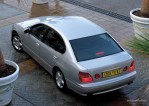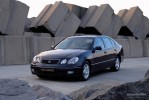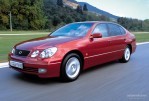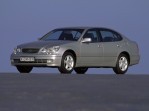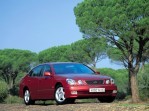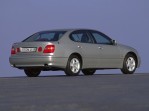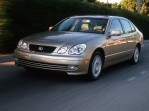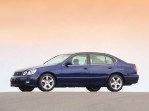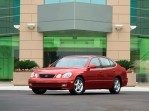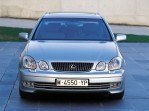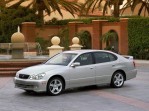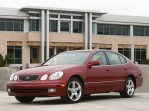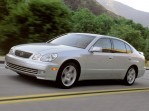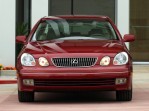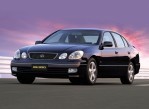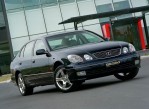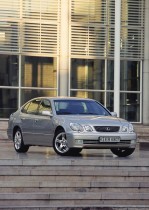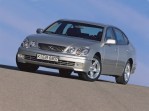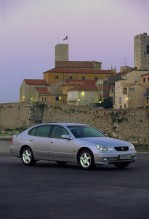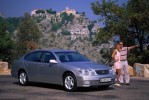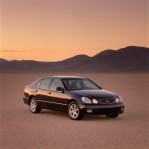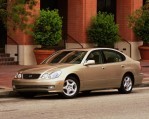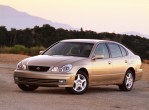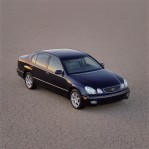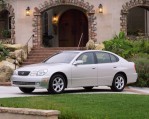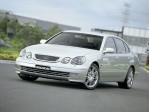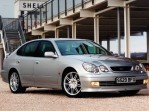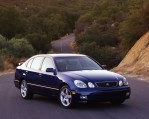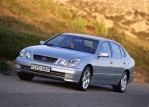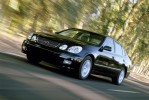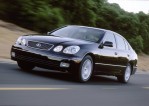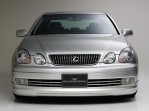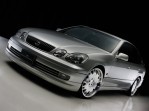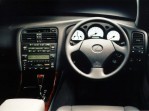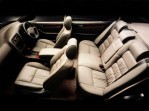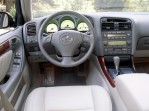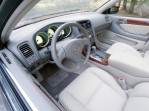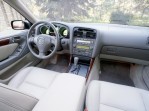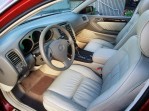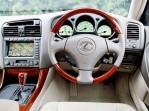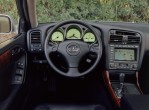Segment: Medium Premium
Production years: 1997, 1998, 1999, 2000
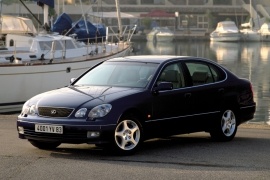 49 Photos
49 PhotosLexus didn’t want to wait too long and postpone the launch of a new generation for the GS lineup, and in 1997, the automaker introduced the second iteration of this nameplate, sold in the U.S. as a 1998 model year.
The first generation of the GS was kept on the market for just four years before the automaker replaced it. Unlike the previous model, which was designed by Italdesign Giugiaro, Akihiro Nagaya, part of the Lexus design team, penned the second iteration of this nameplate. It was a radical new idea, and suddenly, the GS didn’t look like a European premium sedan. Its visual identity was different than any of its competitors. The interior was also significantly upgraded and provided more of everything, from roominess to amenities. There were only minor changes to the engine compartment, where the 2JZ-GE powerplant remained in use.
Lexus was already reckoned for its high-quality products in the premium segment. The automaker’s obsession with perfect finishes was second to none in its category, and everybody started to respect that. And that was easy to notice on the GS’s front fascia, which featured four triangular headlights with rounded corners instead of two, as on the previous generation of this nameplate. They flanked a trapezoidal chromed grille adorned by slim vertical slats where the carmaker’s badge took center stage. Lower, on the bumper, the GS lineup retained the broad, single-slat air intake flanked by fog lamps as its predecessor. However, it was complemented on the lower side by an apron to look sportier.
With a shorter wheelbase and overall length, the second generation of the GS revealed a more compact dimension, making the greenhouse look taller than before. Furthermore, the arched C-pillars still followed the idea of the organic look of its predecessor, even though the biodesign styling had already started to go out of trend. At the back, the GS sported a unique taillight design that echoed the car’s front look. It featured a pair of corner-mounted lamps on the rear side of the quarter panels, with an additional set of brake lights placed on the trunk’s lid, flanking the license plate. As a result, customers looking for an upscale vehicle could easily see the difference between a Lexus GS and any other premium vehicle.
Inside, despite the shorter wheelbase, the cabin was roomier than its predecessor's. Depending on the vehicle’s grade, customers were spoiled by a leather-wrapped interior and wood trims on the dash and center console. Fronting the driver was a binocular-style instrument panel, with the speedometer in the middle and an LCD at the bottom for the odometer. On the left was the tachometer, while the right dial was shared by the fuel and coolant temperature gauges, plus the indicator for the gearbox. The seats were designed for comfort and provided only average side bolstering up front. At the same time, those seated in the back had plenty of legroom and headroom. However, the shoulder room was adequate mostly for two occupants who could share the center folding armrest. Like most other RWD cars, the GS had a tall transmission tunnel that crossed the vehicle front to back.
Under the hood, the 1998 Lexus GS was available with a choice of gasoline engines. While the Toyota Crown from the same era was fitted by the automaker with the mighty 2JZ-GTE twin-turbocharged inline-six powerplant carried over from the Supra TT, the GS had only the naturally aspirated version of it, namely the 2JZ-GE. Those craving for a more potent powerplant could choose the four-liter V8 engine. Both versions were mated to a five-speed automatic.
LEXUS GS 1997, 1998, 1999, 2000
- 300 5AT RWD (222 HP)
- 400 V8 5AT RWD (294 HP)
LEXUS GS
300 5AT RWD (222 HP)
ENGINE SPECS - 300 5AT RWD (222 HP) | |
|---|---|
| Cylinders: | L6 |
| Displacement: | 2997 cm3 |
| Power: | 163 KW @ 5800 RPM 222 HP @ 5800 RPM 219 BHP @ 5800 RPM |
| Torque: | 220 lb-ft @ 3800 RPM 298 Nm @ 3800 RPM |
| Fuel System: | Multipoint Injection |
| Fuel: | Gasoline |
PERFORMANCE SPECS | |
|---|---|
| Top Speed: | 142.9 mph (230 km/h) |
| Acceleration 0-62 Mph (0-100 kph): | 8.2 s |
TRANSMISSION SPECS | |
|---|---|
| Drive Type: | Rear Wheel Drive |
| Gearbox: | 5-speed automatic |
BRAKES SPECS | |
|---|---|
| Front: | Ventilated Discs |
| Rear: | Ventilated Discs |
TIRES SPECS | |
|---|---|
| Tire Size: | 225/55VR16 |
DIMENSIONS | |
|---|---|
| Length: | 189 in (4801 mm) |
| Width: | 70.9 in (1801 mm) |
| Height: | 56.7 in (1440 mm) |
| Front/rear Track: | 60.6/59.4 in (1,539/1,509 mm) |
| Wheelbase: | 110.2 in (2799 mm) |
| Ground Clearance: | 5.5 in (140 mm) |
| Cargo Volume: | 18.2 cuFT (515 L) |
| Aerodynamics (Cd): | 0.31 |
WEIGHT SPECS | |
|---|---|
| Unladen Weight: | 3814 lbs (1730 kg) |
| Gross Weight Limit: | 4673.8 lbs (2120 kg) |
FUEL ECONOMY (NEDC) | |
|---|---|
| City: | 14.7 mpg US (16 L/100Km) |
| Highway: | 26.7 mpg US (8.8 L/100Km) |
| Combined: | 20.6 mpg US (11.4 L/100Km) |
| CO2 Emissions: | 272 g/km |
LEXUS GS
400 V8 5AT RWD (294 HP)
ENGINE SPECS - 400 V8 5AT RWD (294 HP) | |
|---|---|
| Cylinders: | V8 |
| Displacement: | 3969 cm3 |
| Power: | 216.2 KW @ 6000 RPM 294 HP @ 6000 RPM 290 BHP @ 6000 RPM |
| Torque: | 310 lb-ft @ 4000 RPM 420 Nm @ 4000 RPM |
| Fuel System: | Multipoint Injection |
| Fuel: | Gasoline |
PERFORMANCE SPECS | |
|---|---|
| Top Speed: | 155 mph (249 km/h) |
| Acceleration 0-62 Mph (0-100 kph): | 5.7 s |
TRANSMISSION SPECS | |
|---|---|
| Drive Type: | Rear Wheel Drive |
| Gearbox: | 5-speed automatic |
BRAKES SPECS | |
|---|---|
| Front: | Ventilated Discs |
| Rear: | Ventilated Discs |
TIRES SPECS | |
|---|---|
| Tire Size: | 225/55VR16 |
DIMENSIONS | |
|---|---|
| Length: | 189 in (4801 mm) |
| Width: | 70.9 in (1801 mm) |
| Height: | 56.7 in (1440 mm) |
| Front/rear Track: | 60.6/59.4 in (1,539/1,509 mm) |
| Wheelbase: | 110.2 in (2799 mm) |
| Ground Clearance: | 5.5 in (140 mm) |
| Cargo Volume: | 18.2 cuFT (515 L) |
| Aerodynamics (Cd): | 0.31 |
WEIGHT SPECS | |
|---|---|
| Unladen Weight: | 3814 lbs (1730 kg) |
| Gross Weight Limit: | 4673.8 lbs (2120 kg) |
FUEL ECONOMY (NEDC) | |
|---|---|
| City: | 17 mpg US (13.8 L/100Km) |
| Highway: | 23.1 mpg US (10.2 L/100Km) |
| Combined: | 20.6 mpg US (11.4 L/100Km) |
| CO2 Emissions: | 272 g/km |
